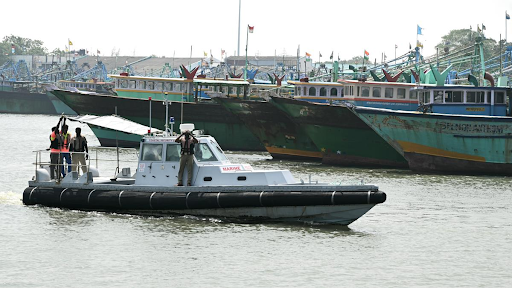Description

Source: PIB
Disclaimer: Copyright infringement not intended.
Context
Vice Admiral Rajesh Dhankhar NM, assumed duties of the Director General Project Seabird.
Details
- Project Seabird is one of the largest and strategically most vital naval infrastructure projects that were undertaken to develop a world-class naval base at Karwar, Karnataka on the west coast of India.
- It was born under the initiative taken by Admiral O.S. Dawson in the early 1980s.
- The project was sanctioned in 1985 and its foundation stone laid by then Prime Minister Rajiv Gandhi in 1986.
Purpose and Need:
Project Seabird was born out of the need felt in the aftermath of the Indo-Pak War in 1971 underlining the need to have another base for the Indian Navy because of the congestion at Mumbai Harbour thus presenting a risk to the security of the Western Fleet.
Stages of Development
- Stage I (Completed in 2005): The phase included the construction of deep-sea harbor, breakwaters, dredging, township, naval hospital, dockyard uplift center, and ship lift facility. The base commissioned with a strength to support 10 ships.
- Phase II: (In Progress, Fulfilled in two parts-Phase IIA and Phase IIB)
- Phase IIA: Berthing facilities, new covered dry dock, and extensive residential facilities are under construction.
- Phase IIB (Future development): INS Kadamba is the center of Project Seabird and currently the third-largest Indian naval base, which would expand to become the largest once Phase IIB is completed. Naval Air Station is under construction, with a 2,700-meter runway that would support naval and commercial aviation.
- INS Vajrakosh: A nearby naval station involved in missile storage and maintenance.
- INS Jatayu is a recently established naval base in the Lakshadweep islands.
Sources: PIB
|
PRACTICE QUESTION
Q: Consider the following statements with reference to Project Seabird:
1. The Project Seabird at the Karwar Naval Base is the country's largest naval infrastructure project.
2. The project also involves the construction of INS Kadamba, which is supposed to become the most crucial naval base on the eastern coast for the Indian Navy.
3. Project Seabird assumes strategic importance in view of the location that would allow the Indian Navy to increase its operational reach both in the Bay of Bengal and beyond.
Which of the above statements are correct?
(a) 1 only
(b) 1 and 3 only
(c) 2 and 3 only
(d) 1, 2, and 3
Answer: (a)
Explanation:
- Statement 1 is correct: Project Seabird aims at developing a state-of-the-art naval base on the western coast of India, specifically in Karwar, Karnataka. It is designed to be self-sufficient, with the capacity to dock and maintain some of the Indian Navy's largest warships, including aircraft carriers and submarines.
- Statement 2 is incorrect: INS Kadamba does fall under Project Seabird; however, it is on the western coast of India and not the eastern coast. It so happens to be one of the biggest naval bases in Asia and serves as one of the main strategic assets for the Indian Navy.
- Statement 3 is incorrect: The strategic location of Project Seabird near the Arabian Sea will enhance the power projection capabilities of the Indian Navy in the Indian Ocean region, protection of vital sea lanes, and rapid response to maritime threats.
|










